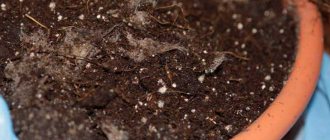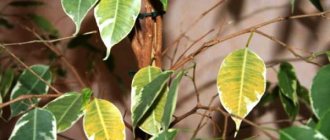Plants » Flowers
0
2915
Article rating
Kira Stoletova
Ficus is very popular, especially a variety like Benjamin. It is unpretentious and easy to grow at home. All this plant needs is good watering and timely feeding. Despite the unpretentiousness of the flower, diseases of Ficus Benjamin can still cause inconvenience to its owners. And besides ailments, it can also be attacked by various parasites.
Ficus benjamina diseases
Most often, diseases and pests in plants occur due to improper care or infection from other flowers. Ficus, like humans, needs to be prevented from various types of ailments. Diseases and pests of Ficus Benjamin with photos can be easily found on the Internet. So why do diseases occur in this plant?
Causes of ficus diseases
A plant of this species may become covered with pale spots or the leaves may turn yellow. Most often, this does not mean that Benjamin’s ficus has contracted some kind of disease. To make sure of this, you first need to assess its location. Maybe he just doesn't get enough sunshine. We need to try moving it to a more illuminated place.
Diseases can also occur due to insufficient watering. During this period, the leaves become dry and begin to fall off.
This flower needs to be watered quite often, otherwise it will simply die, but this does not mean at all that the plant needs to be watered. No flower can handle a lot of water.
Ficus benjamina was bred in warm countries, so the temperature in the house should be somewhere around 23°C. If the air is cold or the flower gets used to standing in a draft, it will simply shed its leaves, and very high temperatures can cause the plant to turn dark brown.
If the plant does not receive enough nutrition, it will be attacked not only by diseases, but also by pests, so not only regular watering should be carried out, but also the application of mineral fertilizers. It is necessary to feed the flower at least once a month.
What can a ficus suffer from? How to identify a disease by the leaves of a plant and cure it?
Powdery mildew is considered one of the most common diseases of ficus. This disease is easily recognized by white spots on the leaves of the flower, which can be wiped off with your hand.
Powdery mildew on ficus
The cause of this disease can be an excess of direct sunlight, too high a room temperature, excess humidity, as well as damage to leaves by insects. Treatment is best done at the initial stage, using a soap solution and a sponge. If the leaves are already too heavily stained, they must be removed and the plant sprayed with a fungicide.
Another most common disease of ficus and other indoor plants is anthracnose or rust. This disease is accompanied by the appearance of yellow to dark brown spots. Later, the leaves become covered with ulcers, and the ficus begins to shed them, as a result of which it can become completely bare. You can cure flowers affected by rust using a fungicide.
Ficus anthracnose
Ficus trees can also be susceptible to diseases caused by mold, such as botrytis or gray mold. These diseases are characterized by the appearance of a dark coating on the leaves of the plant, which, when shaken, flies through the air. Over time, the leaves of the flower may completely darken and fall off. The cause of this disease is high humidity and high temperature in the room in which the flowers are located. The disease can be cured by removing damaged areas of the plant and treating it with a fungicide and insecticide.
Botrytis (grey mold) on ficus
Excessive watering of plants can cause a disease called root rot. It is difficult to notice, since it occurs in the ground and is only accompanied by withering of the plant. The root system ceases to function properly, and the ficus dies over time. Unfortunately, it is impossible to cure this disease; the plant must be thrown away along with the pot.
If black spots similar to soot appear on the leaves of a plant, then it has suffered from a disease called sooty fungus. It is impossible to notice such a plaque, and the plant begins to emit a rotten smell. In this case, it is necessary to wipe the leaves with a sponge and soapy water and treat the plant with a fungicide.
Sooty mushroom on ficus
Dampness and excessive humidification of indoor air can cause cercospora disease. It is accompanied by the appearance of small brown or black spots on the lower part of the leaves of the plant. Then these spots increase, the leaves turn yellow and fall off; If the disease is neglected, the flowers may even die. Cercospora blight can be cured using a fungicide and other antifungal drugs.
Cercospora blight on ficus
Almost all of these diseases appear due to damage to ficus by fungi, which easily spread and take root on plants due to poor care. To prevent fungal infections, it is necessary to create comfortable living conditions for flowers, and to ensure timely detection of ailments, ensure regular inspection of plant leaves. In addition to improper care, indoor plants have other enemies - these are all kinds of insect pests that develop in the spores of a flower and feed on its juice; each of them is worth talking about separately.
Remove the ficus from the pot and shake off all the soil from the roots. If upon examination you find that the roots are dark and soft, then, alas, all that remains is to throw away this flower; there is no help for it. The plant can only be helped if more than 50% of the roots are in satisfactory condition. We take scissors and cut off all the darkened areas of the root system. After all the rot has been removed from the roots, you need to cut off the same amount of branches and leaves. This is done to make it easier for the ficus to survive the disease and achieve full recovery. If you do not trim the crown, the flower will spend its energy only on maintaining greenery and will take a very long time to recover. After all the procedures, you should plant the flower in new soil and water it with a solution of carbendazim fungicide. Place the flower in a warm, illuminated place, but not in direct sunlight, and do not water until new leaves begin to appear. Next, you need to strictly observe the watering regime and air humidity.
Caring for Ficus Benjamin
The ficus may become exposed to the trunk. The main reason for this phenomenon can be only one thing, untimely transplantation into poor, unfertilized soil. It must be remembered that replanting should be done once a year, this is a prerequisite for good and healthy growth of the plant. And of course, fertilizers throughout the entire growth period.
As you can see, the main causes of diseases of this plant are improper care of ficus benjamina. Maintenance is not difficult, you just need to remember the basic rules:
Optimal conditions for growth and avoidance of diseases of Ficus Benjamin
Often diseases appear in ficus due to the wrong location or air temperature, therefore, in order for the flower to be comfortable, it must be placed in a place where there is good lighting and no draft. Often it is a draft that causes the death of a plant. For Ficus Benjamin, the optimal air temperature is 15°C.
You need to water the flower in moderation. In the summer, this should be done no more than 2 times a week. In cold weather, watering is carried out once every 10 days. Only under such conditions of detention can the occurrence of various ailments be avoided.
Features of combating leaf diseases
Inappropriate indoor microclimate and improper care also provoke leaf diseases.
Did you know? The sap of the rubber ficus consists of 15% rubber. This plant was the main raw material for the production of latex until a way to obtain it synthetically was found.
One of the most common is yellowing of leaf blades and their falling off. This pathology is caused by dry air.
It often appears in winter in plants located in close proximity to heating devices. Yellowing and falling leaves can also be caused by the stress that plants experience when changing location frequently.
Large loss of foliage leads to the death of the plant. They correct the situation by installing air humidifiers and selecting a suitable location. If it is not possible to move the plant away from the battery, it should be covered with a damp cloth and constantly monitored so that it does not dry out.
Find out why the ficus sheds its leaves and how to treat the plant.
As a result of lack of nutrition, the leaves of the Benjamin ficus are underdeveloped, become smaller, and the old ones turn yellow and crumble. In this case, you need to transplant into a new nutrient substrate, which will include peat, leaf humus and sand in equal proportions.
Fitosporin can be used as a disinfectant and soil enriching agent. Add 1 g of the drug to 1 liter of water.
Leaf dieback can be caused by infections, viruses or pests. In such cases, it is necessary to carry out a diagnosis by examining all the leaves and shoots under a magnifying glass. It is also worth removing the top layer of soil and assessing the condition of the roots. In case of severe lesions, it is better to replant and treat with fungicides.
If pests are present, use insecticidal preparations.
Ficus benjamina pests
Proper care allows you to avoid a variety of diseases, but it is almost impossible to prevent the appearance of pests. The reason for their appearance can be varied. Most often they occur due to high humidity and unsuitable air temperature. If pests appear, but the leaves become sticky, spots and even cobwebs may form. One such parasite is the mealyworm, which is indicated by curling and wilting of leaves.
Ficus Benjamin is often affected by a parasite such as a mite. Because of this, the level of photosynthesis decreases, and over time the flower may even die. Another pest is aphids. Because of it, the leaves turn yellow and fall off over time. These ficus benjamina parasites with photos can be easily found on the Internet.
A brown spot indicates that the flower is being attacked by a scale insect. This parasite sucks all the juices out of the plant and leaves a sticky coating, which can cause sooty fungus to appear. In order to cope with scale insects, it is necessary to treat the leaves with insecticidal oil and a special varnish for the plant. At home, you can use a soap solution.
Most of the pests occur due to the fact that the ficus was not properly cared for. But there are also those that appear regardless of watering and feeding, so the flower should be checked daily for the presence of parasites.
Infectious diseases of ficus
The problems with the flower do not end with pests. Ficus benjamina can easily become infected with infectious diseases. Their treatment is carried out using special solutions. During this period, the plant needs special care and more attention. Such ailments most often appear due to parasite secretions or dew.
In order to get rid of this kind of disease, it is necessary to prepare a fungicide solution. Before treating the ficus, it is necessary to remove the affected leaves from the plant. If after the first spraying the disease does not go away, you need to repeat the treatment again.
Fungal diseases include mold and rot. If timely treatment is not carried out, you can lose the flower, because these ailments affect not only the stem and leaves of the plant, but also the root.
Infections and fungal infections
Proper care will keep any plant healthy. But sometimes even he is not able to get rid of unwanted problems that arise due to the diligent care of the gardener. Ficus diseases also occur due to external factors: initially hidden diseases in newly purchased plants, cuttings, when replacing the soil mixture or transplanting into open ground.
Infections and fungal infections of ficus
Attention! Even prepared soil purchased in a store does not always guarantee that conscientious manufacturers have disinfected it from ficus pest larvae.
The most common diseases of any type of ficus genus include:
Powdery mildew
White spots that look like a fluffy coating that are easily erased.
Reason: from direct sunlight, places damaged by insects, subsequently infected with fungus. Treatment: The plaque is washed off with a sponge soaked in soapy water. Severely affected leaves are removed. The plant is treated with a fungicide.
Anthracnose or rust
Uneven, rusty spots with a brown border along the edge of the leaf. After some time, holes form in their place. Later the leaves completely darken and die. Cause: Fungus Colletotrichum orbiculare. Treatment: Diseased areas are cut off, the ficus is treated with fungicide and copper oxychloride.
Cercospora
Small brown or black dots at the bottom of the leaf, which gradually increase in size. After a couple of days, the leaf withers and dies. Reason: Dampness, waterlogging in the room. Infection with a fungus of the genus Cercospora. Treatment: spraying with a fungicidal preparation.
Bacterial diseases of ficus
In addition to fungal and infectious diseases, there are also bacterial ailments. They are no less dangerous for ficus Benjamin. Particularly common are Agrobacterium tumafaciens and Xanthomonas.
Agrobacterium tumafaciens is a disease in which the entire flower is covered with small blisters. Over time, these bubbles turn into scales and peel off. With this disease, any treatment is useless, so the flower must be destroyed.
Xanthomonas is a blistering disease. Over time, each bubble increases in size and turns brown. No treatment will help in this case, so the flower is simply thrown away.
Methods for treating fungal diseases
Fungal diseases can be treated in several ways.
They are:
- Spraying with fungicides. If simple methods (changing temperature, air humidity, etc.) do not help, then move on to fungicides. Spraying a flower with a solution makes it possible to get rid of almost all fungal infections.
- Trimming. Pruning is often carried out when fungicides can be dispensed with or they have not had the desired effect. This method is especially relevant for root rot, when some roots can still be saved. In this case, the ficus is taken out of the pot and the root system is carefully examined. Rotten roots are cut off and thrown away, and after that the plant is transplanted into new soil and a new flowerpot.
- Folk remedies. This technique is good when the disease has just made itself felt. In this case, the flower can be treated with soapy water, garlic or alcohol.
Sources of diseases and pests of ficus
Most often, problems with ficus are associated with improper care or lack thereof. It depends on it how the flower will develop, so if a Benjamin ficus appears in the house, you must try to provide it with quality care.
Main sources of diseases and pests:
- inappropriate lighting;
- very low or high air temperature;
- improper humidity;
- incorrectly selected fertilizer;
- unsuitable soil.
Owners of such a flower often complain that it withers and the leaves turn yellow. In this case, you should pay attention to watering. It may be that there is too much of it or, conversely, not enough.
In order to avoid such problems with Ficus Benjamin, it is necessary to avoid such mistakes. Prevention methods are also recommended. What are they?
Prevention of ficus diseases
If you properly care for your ficus benjamina, you can avoid many problems in the future, so it is necessary to take some preventive measures. The first and most important thing to do is to inspect your ficus every day for diseases or pests. At the slightest manifestation of the disease, it is necessary to immediately treat the flower.
The leaves of the plant must be wiped every day with a special solution. It is made with soap and plain water. This procedure must be carried out if the ficus was outdoors in the summer. It is advisable to place young flowers separately from older ones. Only after adaptation can the ficus be placed next to other plants.
Flowerpots of all colors should be placed at a sufficient distance from each other. If this rule is not followed, a disease may occur that will affect all plants. It is also necessary to regularly remove the grass from the flowerpots so that it does not suck out all the beneficial properties from the soil; they must go to the ficus.
The soil must be regularly treated with a solution of potassium permanganate. This will prevent the appearance of pests such as midges. If you provide the ficus with such conditions, it will never get sick.











